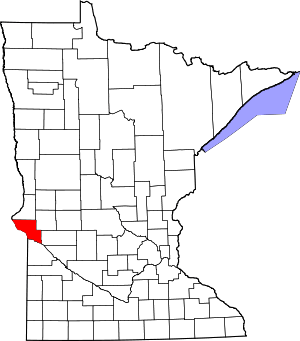Odessa, Minnesota
Odessa is a city in Big Stone County, Minnesota, United States. The population was 135 at the 2010 census.[6]
Odessa | |
|---|---|
 Location of Odessa, Minnesota | |
| Coordinates: 45°15′37″N 96°19′43″W | |
| Country | United States |
| State | Minnesota |
| County | Big Stone |
| Area | |
| • Total | 0.96 sq mi (2.50 km2) |
| • Land | 0.96 sq mi (2.50 km2) |
| • Water | 0.00 sq mi (0.00 km2) |
| Elevation | 961 ft (293 m) |
| Population | |
| • Total | 135 |
| • Estimate (2019)[3] | 131 |
| • Density | 135.75/sq mi (52.42/km2) |
| Time zone | UTC-6 (Central (CST)) |
| • Summer (DST) | UTC-5 (CDT) |
| ZIP code | 56276 |
| Area code(s) | 320 |
| FIPS code | 27-48058[4] |
| GNIS feature ID | 0648897[5] |
History
Odessa was platted in 1879 when the railroad was extended to that point.[7] It was named after Odessa, in the Ukraine.[7]
Geography
According to the United States Census Bureau, the city has a total area of 0.75 square miles (1.94 km2), all of it land.[8]
U.S. Route 75 and Minnesota State Highway 7 (co-signed) serves as a main route in the community.
Demographics
| Historical population | |||
|---|---|---|---|
| Census | Pop. | %± | |
| 1900 | 204 | — | |
| 1910 | 235 | 15.2% | |
| 1920 | 271 | 15.3% | |
| 1930 | 284 | 4.8% | |
| 1940 | 316 | 11.3% | |
| 1950 | 283 | −10.4% | |
| 1960 | 234 | −17.3% | |
| 1970 | 194 | −17.1% | |
| 1980 | 177 | −8.8% | |
| 1990 | 155 | −12.4% | |
| 2000 | 113 | −27.1% | |
| 2010 | 135 | 19.5% | |
| Est. 2019 | 131 | [3] | −3.0% |
| U.S. Decennial Census[9] | |||
2010 census
As of the census[2] of 2010, there were 135 people, 58 households, and 39 families living in the city. The population density was 180.0 inhabitants per square mile (69.5/km2). There were 68 housing units at an average density of 90.7 per square mile (35.0/km2). The racial makeup of the city was 100.0% White. Hispanic or Latino of any race were 3.0% of the population.
There were 58 households, of which 20.7% had children under the age of 18 living with them, 56.9% were married couples living together, 5.2% had a female householder with no husband present, 5.2% had a male householder with no wife present, and 32.8% were non-families. 24.1% of all households were made up of individuals, and 10.3% had someone living alone who was 65 years of age or older. The average household size was 2.33 and the average family size was 2.79.
The median age in the city was 48.1 years. 18.5% of residents were under the age of 18; 3% were between the ages of 18 and 24; 25.1% were from 25 to 44; 31.1% were from 45 to 64; and 22.2% were 65 years of age or older. The gender makeup of the city was 54.8% male and 45.2% female.
2000 census
As of the census[4] of 2000, there were 113 people, 55 households, and 34 families living in the city. The population density was 149.4 people per square mile (57.4/km2). There were 66 housing units at an average density of 87.3 per square mile (33.5/km2). The racial makeup of the city was 100% White.
There were 55 households, out of which 14.5% had children under the age of 18 living with them, 54.5% were married couples living together, 5.5% had a female householder with no husband present, and 36.4% were non-families. 32.7% of all households were made up of individuals, and 16.4% had someone living alone who was 65 years of age or older. The average household size was 2.05 and the average family size was 2.57.
In the city, the population was spread out, with 12.4% under the age of 18, 6.2% from 18 to 24, 22.1% from 25 to 44, 32.7% from 45 to 64, and 26.5% who were 65 years of age or older. The median age was 50 years. For every 100 females, there were 101.8 males. For every 100 females age 18 and over, there were 98.0 males.
The median income for a household in the city was $23,125, and the median income for a family was $28,750. Males had a median income of $21,250 versus $25,625 for females. The per capita income for the city was $13,905. There were 11.4% of families and 11.0% of the population living below the poverty line, including 20.0% of under eighteens and 6.8% of those over 64.
References
- "2019 U.S. Gazetteer Files". United States Census Bureau. Retrieved July 26, 2020.
- "U.S. Census website". United States Census Bureau. Retrieved 2012-11-13.
- "Population and Housing Unit Estimates". United States Census Bureau. May 24, 2020. Retrieved May 27, 2020.
- "U.S. Census website". United States Census Bureau. Retrieved 2008-01-31.
- "US Board on Geographic Names". United States Geological Survey. 2007-10-25. Retrieved 2008-01-31.
- "2010 Census Redistricting Data (Public Law 94-171) Summary File". American FactFinder. U.S. Census Bureau, 2010 Census. Retrieved 23 April 2011.
- Upham, Warren (1920). Minnesota Geographic Names: Their Origin and Historic Significance. Minnesota Historical Society. p. 55.
- "US Gazetteer files 2010". United States Census Bureau. Archived from the original on January 12, 2012. Retrieved 2012-11-13.
- "Census of Population and Housing". Census.gov. Retrieved June 4, 2015.
External links
- Parry, Albert (Spring 1944). "US towns named Odessa". Russian Review. 3 (2): 36–40. doi:10.2307/125407. JSTOR 125407.
